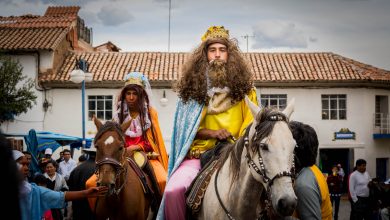The Lord of Miracles Takes to the Streets Today

Peru’s great Lord of Miracles makes his annual procession through the streets of Lima today and tomorrow. Born by devotees, he comes out of the Nazarenas Church and is joined by large masses of people as he makes his way to the Church of Our Lady of Victories (Nuesta Señora de las Victorias) before making his way back home on Sunday.
Besides in Lima, images of the Lord of Miracles will process in cities throughout Peru, including Cusco, as well as in other countries where there are Peruvians and people devoted to him. This event is one the greatest events of the year in Peru where it mobilizes tens of thousands of people, and maybe even hundreds of thousands, and is at the center of a vast network of social, economic, and spiritual life. It is also considered one of the largest manifestations of Catholicism in the world.
The image at the center of all this faith and activity, the Lord of Miracles, was painted on a rustic, adobe wall in 1651 by an Angolan slave called Benito in the heart of what was then a neighborhood of Africans called Pachacamilla. The Black people were divided into castes according to language group and the Angolans were the most numerous and also considered those of least status.
Yet, despite that the Lord painted on the wall survived an earthquake in 1655 that devastated much of Lima and subsequently showed miraculous ability at dealing with telluric movements and many other phenomena, as his devotions spread.
The neighborhood was named after Pachacamac, an extensive and wondrous ritual complex to the south of Lima widely considered in the sixteenth and seventeenth centuries to have been one of the three most important in the Viceroyality of Peru, the other two being Cusco and Titicaca. Pachacamac was famous for its great Lord at the center of its devotional practice, an oracle who was famous throughout the length and breath of the Andes.

This time, in the mid seventeenth century, marked a surgence of Catholic images for ordinary Peruvians that restated some of the parameters of thousands of years of Peruvian religious history. Colonial fears and constraints weakened and the religious life of the people surged with their own saints and devotions, such as the Lord of Miracles and the Virgen of Copacabana from the other site of historic devotion, Titicaca.
Eventually, the Lord of Miracles became known as the holy patron of Peru.




